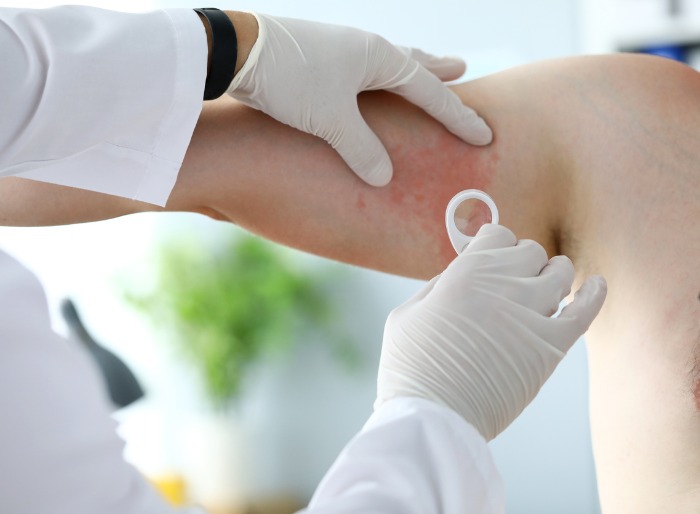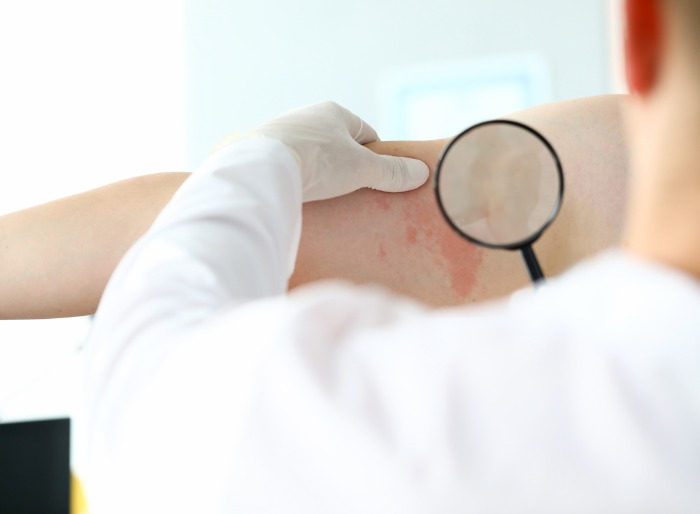If you’ve had chicken pox or the chicken pox vaccine, you might develop shingles, also called herpes zoster. Shingles is common among individuals throughout the United States and around the world. In fact, the Centers for Disease Control estimate every one in three individuals within the U.S. are at risk of developing shingles during their lifetime. If you have previously had chickenpox, believe you may be at risk of developing shingles, or would like to discuss possible shingles treatments, please contact our dermatologists in Gainesville, FL, with Dermatology Associates. Our medical dermatology is dedicated to providing each patient with the highest quality of care possible and innovative treatments designed to improve their quality of life. Contact us today to learn more and to schedule an appointment for treatment.

What Is Shingles?
The herpes zoster infection is caused by the varicella-zoster virus, which also causes chickenpox. Shingles can occur anywhere on the body but often appears as a single stripe of blisters around either side of the torso. Shingles is not a life-threatening condition, however, can be extremely painful. Vaccination can help reduce your risk of shingles, and early treatment can help reduce your chance of developing long-term complications, such as neuralgia.
What Causes Shingles?
Shingles is caused by the varicella-zoster virus. This virus is identical to the virus that causes chickenpox. Any person who’s had chickenpox, or less likely the chickenpox vaccine, is at risk of developing shingles. Once you recover from chickenpox, the virus lies dormant for years within your nervous system. Eventually, it can reactivate, travel along your nerve pathways to your skin and develop into shingles. The exact reason for shingles is unknown, but potential herpes zoster causes may include reduced immunity to infections as a person grows older.
Shingles is far more common in older adults than younger individuals, and it is more prevalent in those with weakened immune systems than otherwise healthy people. Varicella-zoster belongs to a group of herpes viruses, which can cause cold sores and genital herpes. As such, shingles is also known as the herpes zoster virus or herpes zoster. However, it is important to note that the virus that causes shingles is not the same one responsible for cold sores and genital herpes (a sexually transmitted disease).
Shingles Symptoms
For most individuals with shingles, pain is usually the first symptom they experience. For some, the pain can be intense, and depending on the location, it may be mistaken for kidney problems or a pulled muscle. Some individuals experience shingles pain without ever developing a rash. Herpes zoster symptoms and signs usually affect a small area of one side of the body, such as the left or right side of the trunk. These symptoms and signs may include the following.
- Pain, numbness, burning, or tingling sensations
- A red shingles rash that begins multiple days after the pain
- Sensitivity to touch
- Blisters filled with fluid that break open and crust over
- Itchiness and discomfort
- Fever and headache
- Sensitivity to light
- Fatigue and lethargy
What Does Shingles Look Like?
The shingles rash can present as a distinctive cluster of fluid-filled lesions or blisters often occurring in a band formation around the waist. Most commonly, the shingles rash develops as a stripe of oozing blisters around the torso’s left or right side. In some cases, the shingles rash occurs around one eye or, with shingles on face skin, it can appear on one side of the neck or face. However, shingles blisters can develop anywhere on the body. You should contact your doctor promptly if you suspect you have shingles, but especially if you experience the following signs.
- You have pain and a rash near your eye. If left untreated, the infection can lead to permanent ocular damage.
- You are 60 years of age or older, as age significantly increases your risk of complications.
- You or a family member has a weakened immune system or a suppressed immune system, such as to cancer treatment or a chronic illness.
- The rash is widespread and painful.
How Is Shingles Diagnosed?
In most cases, shingles can be diagnosed with a physical skin examination for rashes and blisters. Your doctor will also ask you questions about your medical history. In rare situations, your doctor may need to test a sample of your skin or the fluid filling your blisters. This sample of tissue or fluid is taken using a sterile swab. Samples taken are then sent to a medical laboratory to confirm the presence of the shingles virus. For more information about how shingles is diagnosed, please contact Dermatology Associates.
How Is Shingles Treated?
There is no cure for shingles, however, obtaining shingles treatment as soon as possible can help prevent complications and speed up the recovery process. Ideally, patients with shingles should be treated with the herpes zoster treatment within 72 hours of developing symptoms. Antiviral medications, such as acyclovir, famciclovir, and valacyclovir, may ease discomfort and reduce the duration of symptoms. Your doctor may prescribe medications to help ease your symptoms and shorten the length of your infection and resulting side effects. These medications have a higher success rate when administered within 72 hours of the first sign of shingles. In accordance with your doctor’s recommendations, over-the-counter pain medications may help relieve mild pain. Certain antibacterial agents can be given to treat bacterial infections of the shingles rash.
Can Shingles Be Prevented?
Two vaccines are available within the United States to help reduce the risk of developing shingles and postherpetic neuralgia, a complication of shingles. For individuals who receive the vaccines and subsequently get shingles, their symptoms are usually less severe and any post-shingles complications are far less likely to develop. The best way to avoid getting shingles is by receiving one of the following vaccinations, as recommended by your doctor.
- Shingrix®
- Zostavax®
Is Shingles Contagious?
Someone with shingles cannot spread shingles to another person, however, they can spread chickenpox. The varicella-zoster virus is spread through direct skin-to-skin contact with the transmission of the fluid that oozes out of the blisters. Rarely, it can transmit by breathing in airborne droplets of the varicella-zoster virus. If your rash is in the blister phase of the illness, doctors recommend that you stay away from individuals who have not had chickenpox or the chickenpox vaccine or are pregnant. Additionally, be sure to keep your rash adequately protected and covered. A person with shingles remains contagious until their shingles rash dries and crusts over. The varicella-zoster virus can only cause chickenpox in individuals who have never had chickenpox or those who have not received vaccinations against chickenpox.
Who Is At Risk Of Getting Shingles?
Individuals who have had chickenpox who are most likely to develop shingles include people with a weakened immune system, such as individuals with cancer or HIV, recipients of an organ transplantation, or those undergoing chemotherapy or other cancer treatments; individuals over the age of 50; individuals who have been ill; individuals who have experienced trauma; and individuals who are under stress. For most people, the virus that causes shingles and chickenpox remains dormant in the body and does not cause problems. While it isn’t clear why the virus is reactivated in some people, it typically occurs in times of stress.
Can You Get Shingles More Than Once?
Unfortunately, yes. Among the most prevalent myths about shingles is that it can only happen once. This isn’t true, however. Individuals who get shingles can get shingles again at a later time. If an individual gets shingles after they have already had shingles, they usually do not develop the shingles rash in the same place as the first time.
How Long Does Shingles Last?
Shingles typically last from the time you begin to feel symptoms until the rash has completely disappeared, which typically takes 3–5 weeks but may take more time. First, a few days before you notice a rash, you might feel pain in an area of your skin. The pain may include sensations of itching, burning, stabbing, or shooting. Then, the raised rash appears as a patch or band, usually on the side of the body and, sometimes, on the face, neck, trunk, chest, back, or abdomen. It may also arise on the arms and legs. Three or four days later, the rash will develop red, oozing, fluid-filled, round, painful, and open blisters. These blisters tend to dry out and crust over within 10 days of appearing. After about 2–3 weeks, the scabs clear up.

Shingles Complications
In some cases, after the shingles rash has disappeared, individuals may continue to experience nerve pain in the same area. This complication of shingles, postherpetic neuralgia, can last for months or years after the rash disappears and can become severe in intensity. It is not known why some people get postherpetic neuralgia, and others don’t. It is thought to result from certain individuals becoming more sensitive or damage to the central nervous system from the virus. Other complications can include other types of nerve problems, such as itching, numbness, bacterial infection of the shingles rash, and inflammation in the eye and ear if the rash is located near these organs. Contact us for more information about complications.